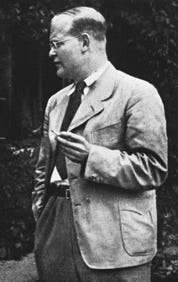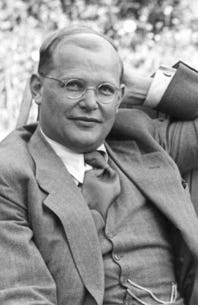Reflections on “Bonhoeffer: Pastor. Spy. Assassin.” (the Movie and the Man)
There are those today who have commandeered Bonhoeffer to boost their authoritarian agenda.
The trailer to Bonhoeffer: Pastor. Spy. Assassin. promises the viewer a gripping, action-packed spy thriller. In his prefatory remarks introducing the movie, the writer, producer, and director, Todd Komarnicki, primes the audience to receive the Reverend Dr. Dietrich Bonhoeffer as a religious hero for our time. But how so?
Take a close look at the poster dripping with the color blood-red.
The singularly focused, blond-haired Bonhoeffer is suited up for the action. He directs his sly gaze to his right. Why not to his left? Could this be a subtle political statement pointing in the one direction as opposed to the other?
Does Hitler’s split image (split personality?) staring over top of his infernal moustache pull you into his netherworld, or distance you from it?
What about the woman looking aside, eyeing her invisible subject with empathy, in contrast to Herr Hitler’s militant mien? What does her soft presence convey? What part might she play in a dystopian Nazi universe of back-alley brawls, flying bullets, and shattered glass, which the non-fiction writer Erik Larson aptly located In the Garden of Beasts?[i]
And the pistol in Bonhoeffer’s right hand? Is that the clincher?
Are you now sufficiently intrigued? Does a pastor brandishing a handgun quicken your steps toward the action?
As I sat watching the movie, I soon began to question what I was seeing—
· Does the film fairly present the real Bonhoeffer? Which scenes get him right? Which ones go markedly astray?
· Do I recognize him as the Bonhoeffer I met for the first time during my college years seven decades ago?
· Is he the same Bonhoeffer I encountered in The Cost of Discipleship, Life Together, Letters and Papers from Prison, and Ethics, as well as in the meticulous biographical tome his pupil Eberhard Bethge painstakingly crafted of his friend and teacher?[ii]
At times throughout the movie the real Bonhoeffer appears partially recognizable, at other times a caricature of himself. But mostly he is far less complex and nuanced than the person he actually was, as I have come to know him.
As for the externals, isn’t his coiffured and dapper cinematic persona a bit too fussy? Where now are the puffy trousers and frumpy jacket, accented by the cigarette propped between his fingers in that casual pose caught of him in 1939?
Has the kind, generous, composed, principled, and deeply thoughtful German actually morphed overnight into a resolute assassin as the film would lead you to think? Really, now? What’s your definition of an assassin? Must the deed be done or is the thought alone enough? Explain, if you will, just how the man qualifies. There were moments when I thought I was observing a Hollywood stuntman as a stand-in for the real Dietrich Bonhoeffer.
Dietrich labored diligently and faithfully in the field of theology. Yet the film offers barely a morsel of the brilliant theologian. Some scenes, to their discredit, typecast him more like a hastily driven crusader than the irenic person he was, engaged in profound, prolonged, and deep reflection, conversant with a vast repertoire of literary, historical, and philosophical works, and wed to the demanding self-discipline involved in crafting his books, diaries, theses, lectures, letters, and sermons.
As for his life and ministry as a Lutheran pastor and preacher, Dietrich drank deeply from the biblical canon. For him the scriptures were like a great constellation of lights from the heavens with Christ as their north star. Of its pages he was a serious exegete and consummate interpreter. By no stretch of the imagination was he ever a propagandist exploiting the Bible for rightwing or leftwing cannon fodder.
But there are those today in the United States, notably the authors of the Heritage Foundation’s Project 2025 and legions of MAGA Christians and Christian nationalists, who have commandeered Bonhoeffer to boost their authoritarian agenda for the incoming Trump regime.
Blatantly they falsify Bonhoeffer’s legacy to suit their ideological whim. And they abuse the sacrificial honor of his martyrdom to bolster the credibility of their childishly foolish leader who honors no one but himself and a cadre of other dictatorial strongmen.
Unfortunately, despite efforts by its creator and its actors to distance themselves from this misappropriation, the Komarnicki film portrays a hyped version of Bonhoeffer that lends itself to the willfully naïve and theologically apostate supporters of MAGA politics who claim Bonhoeffer as their righteous Gentile and heroic savior in a triumphalist battle for the human soul and the nation. Thus the need for an official disclaimer.
One such Trump devotee whose presidential endorsement (“The Christian Case for Trump”) appeared in the Wall Street Journal on October 16, 2016, is the thoroughly misguided and misguiding Erik Metaxas who slanderously referred to President Biden as “our Hitler.” But in true Trumpian fashion, Metaxas directed his slander at the wrong person.
Metaxas’s biography, Bonhoeffer: Pastor, Prophet, Martyr, Spy, has become a favorite among MAGA Christians and Christian nationalists who enthusiastically rally behind Trump’s brazen and nascent fascism. Metaxas’s depiction of Bonhoeffer is a shoddy piece of politically motivated scholarship that was amply exposed for its infidelity to Bonhoeffer in a scathing 2010 review in The Christian Century by Clifford Green, one of the editors of the Bonhoeffer Works project.
An exponent of fundamentalist end-time spiritual warfare, Metaxas has been called out not only by lead actors in the Komarnicki film, for his manipulation of Bonhoeffer, but also by the International Bonhoeffer Society, Bonhoeffer scholars, and Bonhoeffer family descendants.
One of the most shameful aspects of the film is its symbolization of Bonhoeffer as a Christian pastor with a pistol in his hand, which gives implicit permission to anyone who may rationalize: If Pastor Bonhoeffer can take aim at his enemy, then why can’t I do the same to mine?
Just where Mr. Komarnicki found the gun that he placed in Bonhoeffer’s possession, I do not know. Perhaps I missed something during all my years of reading Bonhoeffer. My hunch is that the pistol was a powerful projection and useful means for beefing up the movie, which Mr. Komarnicki simply couldn’t resist. A pastor brandishing a pistol would surely seduce almost any audience to come and see just what in God’s name is happening.
Surrounded as we all are, like it or not, by the American gun culture, the film industry sticks it to us as soon as we walk into the theater. The archetypal symbol of America’s love affair with instruments of killing can’t even escape the grip of the peacemaking pacifist, Dietrich Bonhoeffer. I don’t think that Bonhoeffer, were he still alive, could anymore dissuade his gung-ho American “captors” to disown their fetish for power-hungry politics and the idol of the gun than he could have persuaded his Nazi captors in Tegel prison to release themselves from the grip that Hitler held upon their souls.
After all, every Americanized, gun-toting “hero” from John Wayne’s Shootist to Arnold Schwarzenegger’s Terminator has monetized the nation’s cultural addiction to violence until the predictable outcome resulted in live coverage of the January 6th siege of the U. S. Capitol.
And now, as a cameo to the main feature of such abhorrent politics, we have before us a cinematic Bonhoeffer being hijacked by some of the very same people who, come January 2025, will return to Washington, DC, to do their darndest to hijack democracy. Or as they spuriously vow, to Christianize America into their fabricated version of a nationalist Christ.
Despite the film’s deficiencies, excesses, and flagrant exploitation by those willing to corrupt Bonhoeffer to their own sinister purposes, there is something to be said for the film’s implied warning about the rising tide of authoritarianism in America.
In a delicate scene in which Bonhoeffer’s twin sister Sabene is engaged in softly spoken conversation with her brother, she says to him with reference to Germany’s future under the foreboding shadow of Hitler: “Something’s coming. Something unstoppable.”
Whatever else may be taken to heart from seeing the movie (there’s still more one could glean), that solemn moment shared between the two Bonhoeffer siblings presents us with our own urgent wake-up call. For an American Gestapo may soon come knocking on our doors just as it did on Dietrich Bonhoeffer’s when the German Gestapo hauled him off to prison.
The question then will become not how much we remember of Bonhoeffer, but how much we have become like him ourselves, with no gun in hand.
An English officer of the British Secret service, by the name of Payne Best, who was incarcerated with Bonhoeffer at Buchenwald, Regensburg, Schönberg, and Flossenbürg, being all the while unaware of Bonhoeffer’s past, came to know him quite well within the confines of prison. He left behind an abiding portrait of the Bonhoeffer who in no respect matched the character or the behavior of an assassin.
Best wrote: “Bonhoeffer was all humility and sweetness: he always seemed to diffuse an atmosphere of happiness, of joy in every smallest event in life, and of deep gratitude for the mere fact that he was alive. There was something dog-like in the look of fidelity in his eyes and his gladness if you showed that you liked him. He was one of the very few men I have ever met to whom his God was real and ever close to him.”
In the letter Payne Best sent to Bonhoeffer’s family subsequent to Dietrich’s death, he concluded: “In fact my feeling was far stronger than these words imply. He was, without exception, the finest and most lovable man I have ever met. . . . Bonhoeffer was different; just quite calm and normal, seemingly perfectly at ease . . . his soul really shone in the dark desperation of our prison.”[iii]
The last words that Payne Best heard Bonhoeffer speak not long before his execution by hanging at the command of Adolf Hitler were these: “This is the end—for me the beginning of life.”
The prison camp doctor who had seen Bonhoeffer just before his death, not knowing at the time who Bonhoeffer was, wrote this of him ten years later:
“Through the half-open door in one room of the huts I saw Pastor Bonhoeffer, before taking off his prison garb, kneeling on the floor praying fervently to his God. I was most deeply moved by the way this lovable man prayed, so devout and so certain that God heard his prayer. At the place of execution, he again said a short prayer and then climbed the steps to the gallows, brave and composed. His death ensued after a few seconds. In the almost fifty years that I worked as a doctor, I have hardly ever seen a man die so entirely submissive to the will of God.”[iv]
[i] Erik Larson, In the Garden of Beasts: Love, Terror, and an American Family in Hitler’s Berlin (New York: Crown, 2011).
[ii] Eberhard Bethge, Dietrich Bonhoeffer: Man of Vision, Man of Courage (New York: Harper & Row, [German 1957] 1977), 867 pp.
[iii] Bethge, 823.
[iv] H. Fischer-Hüllstrung, “A Report from Flossenbürg,” I Knew Dietrich Bonhoeffer, p. 232, Bethge, 830–31.
Copyright 2024 Charles Davidson – All Rights Reserved






